Your Cart is Empty
🚚 Flat-Rate FedEx Priority Overnight — Just $26.99 (Limited-Time Special!) | FREE over $200
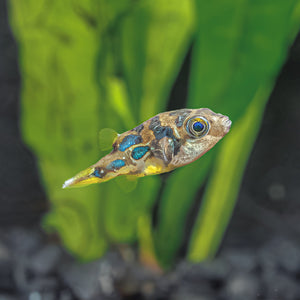
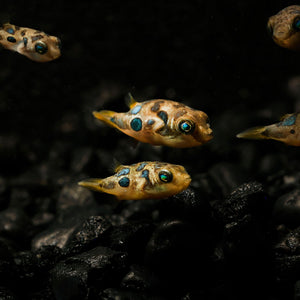
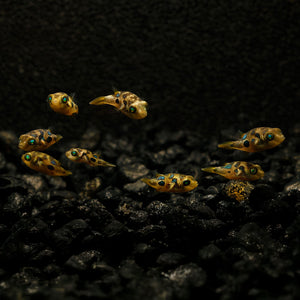
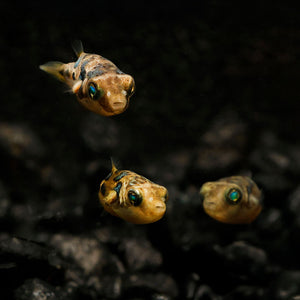
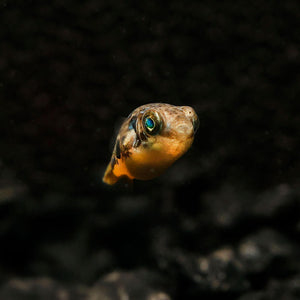
Pea Puffers (scientific name: Carinotetraodon travancoricus) are truly a rewarding addition to your home aquarium, especially for those who appreciate curious and interactive fish. Despite them being a fairly small fish, Pea Puffers are generally highly inquisitive, and owners can watch their lively interactions, territorial displays, and keen awareness of their surroundings. Their bold black patterns on a yellow-gold body make them easy to spot, but it’s their lively behavior in such a small fish that really makes them desired by so many aquarium enthusiasts.
It’s important to note that our Pea Puffers for sale require a diet of live food or frozen foods to thrive, so prospective owners should be prepared to meet these specific food requirements before purchasing. During our 2 weeks quarantine period, we do our best to convert them from live foods to frozen foods to make feeding easier for their new owners.
Quarantined for 2 weeks to ensure health and easy transition
Fed both live and frozen foods during quarantine
Covered by our 100% Live Arrival Guarantee
Shipped quickly and carefully with support if any issues happen
Regularly updated with fresh arrivals so you always get the healthiest pea puffers
Tank Size: 5 gallons for one, 10+ gallons for groups
Water Temperature: 70–74°F
pH: 7.2–7.5
GH: 4–8
KH: 2–4
TDS: 80–120
Temperament: Semi-aggressive
Lifespan: Up to 5 years
Pea puffers do best in a planted tank with low water flow. They like hiding spots and ample space to explore. These help reduce aggression and make them feel at home. In the wild, they are found in low flow rivers, so their tank should mimic these natural conditions. We use a sponge filter to reduce flow without impacting the water quality. It is important to note that they are highly sensitive to elevated nitrate levels so adequate filtration is needed. Their diet in the wild consists primarily of small invertebrates, so offering similar foods in captivity is important.
As carnivorous fish, our pea puffers for sale thrive on a varied diet rich in protein, with a strong emphasis on live foods to support their health and natural behaviors. Observing their eating behavior is crucial to ensure they are receiving proper nutrition and to ensure reduced aggression. Our main live food offerings include:
Daphnia culture: Feeding live daphnia is especially beneficial as it is high in fiber, promoting a healthy digestive system and helping to prevent bloating.
Scud culture: These small crustaceans provide essential nutrients and encourage natural hunting behaviors.
Bladder snails: Besides serving as a nutritious food source, bladder snails assist in keeping the puffers’ beak-like teeth properly trimmed.
In addition to live foods, frozen options such as bloodworms, baby brine shrimp, and frozen daphnia are excellent supplements. However, it is important to avoid overfeeding bloodworms to prevent digestive issues. Many hobbyists also use newly hatched brine shrimp as a live food source.
Creating a natural environment is very important for the health and happiness of pea puffers in your home aquarium. This fascinating species does best in a well-planted tank that looks like their natural home. Adding different aquatic plants like Java moss, Anubias, and Cryptocoryne gives them places to hide and helps keep the water clean. Driftwood, rocks, and caves make the tank more interesting and give your puffers lots of spots to explore and call their own.
To mitigate aggression and territorial behavior, it’s important to give them plenty of space and use plants and decorations to block their view of each other (specifically in male heavy groups). Changing the tank layout or adding new objects sometimes can encourage them to explore and stay active, which helps lower stress. Feeding them a variety of foods like live or frozen daphnia, frozen bloodworms, and small snails also keeps their minds busy and stomachs full.
Experienced fish keepers often suggest keeping a small group of pea puffers together in a tank just for them. This way, you can watch their unique behaviors without worrying about fights with other fish or shrimp. With the right mix of plants, hiding places, and a good diet, your aquarium will be a lively home that brings out the best in these amazing puffers.
Yes, they can be aggressive, especially toward other puffers or fish with long fins. It’s best to keep them alone or in carefully monitored species only groups.
They do better alone or with fast, peaceful fish. They are not considered good options for community tanks. They are known for fin nipping slow or long-finned fish, so you have to choose their tank mates carefully.
Pea puffers are carnivores. They like live or frozen foods, specifically daphnia, scuds and bladder snails. While brine shrimp is a great option, there are plenty of other alternatives.
You can keep pea puffers in groups, but you need plenty of space and plants to give them hiding spots. A 10-gallon tank can hold about 5 pea puffers if it has lots of plants.
With good care, freshwater pea puffers can live 4 to 5 years in your aquarium.